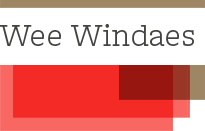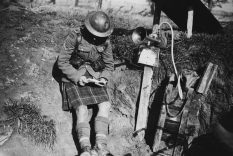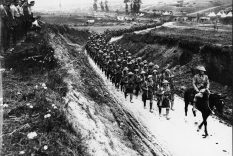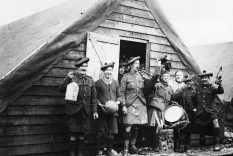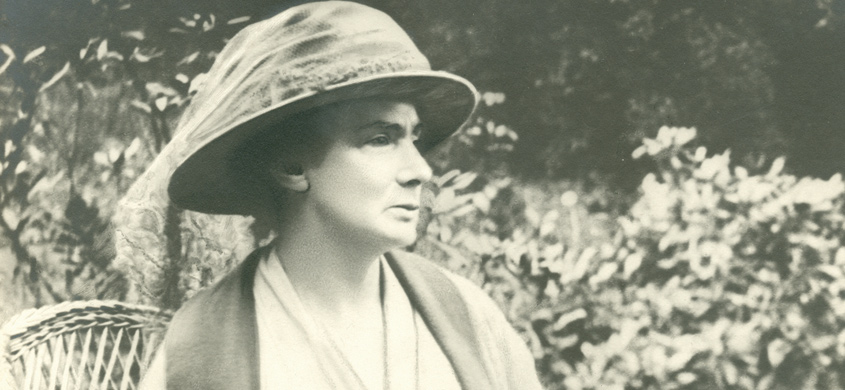
Mary Symon wis born on 25 September 1863 at Dufftown, whaur her faither became provost an wis a foonder o Pittyvaich Distillery. She bidit maist o her years at Pittyvaich Hoose, gangin tae Mortlach Public School an then tae the Edinburgh Institute for Young Ladies whaur she wis taucht bi James Logie Robertson. Yaisin the pseudonym ‘Hugh Halliburton’, Robertson scrievit several warks in Scots includin modrenised versions o Dunbar an owersettins o Virgil’s ‘Horace’.
Mary Symon graduatit frae St Andrews University. In the early 1920s her poetry wis imprentit in Hugh MacDiarmaid’s ‘Northern Numbers’, a magazine at the hert o the modrenist renaissance in Scottish literatur. Her ainly collectit warks, ‘Deveron days’, wis imprentit in 1933. She wid become best kent fir her Scots poems anent the First Warld War, notably ‘The Glen’s Muster Roll; the Dominie Loquitur’ an ‘The Soldiers Cairn’ which baith deal wi the eftercome o war on a rural community.
The ‘Scotland’s War’ online project comments: ‘… in Dufftown, Banffshire there was a spinster in her fifties, whose verse, written during the war and in Scots, caught the public’s imagination and is among the finest war poetry in capturing the grief and loss of that period. Her name was Mary Symon. Her war poems are of national importance.’ Mary Symon deed at Pittyvaich in 1938.
Lear mair aboot Mary Symon (1863-1938)
As the Great War fell in an age jist afore the advent o mass communications in radio an cinema, it wis a conflict that wid witness a muckle increase in imprentit poetry. The feck o this wis imprentit in newspapers, bi baith accomplished poets an in the haund o enthusiastic novices. This phenomenon o war poetry wis widespreid ootthrou Europe. In the pages o daily jurnals as weel as in imprentit collections, France an Germany wid likeweys see a by-ordinar increase in prentit verse.
Wilfred Owen, Rupert Brooke, Siegfried Sassoon an Robert Graves are mindit amang the better kent poets. In Scotland E A MacKintosh, Charles Hamilton Sorley an the bardachd o Gaelic poets, sic as Donald MacDonald o Baile Sear in North Uist, wid add tae the significant canon o verse frae the First Warld War.
Dundee’s Joseph Lee, wha focht at Aubers Ridge, Neuve Chapelle an in the heavily susteened losses at the Battle o Loos, scrievit verse maistly in English, but alsae in Scots, which he sent tae the ‘People’s Journal’ an ‘Dundee Advertiser’. Lee continuit tae send verse tae the Dundee papers eftir he wis takken preesoner-o-war at Cambrai an haudit captive at Karlsruhe. As seen in ‘Sword and Pen; Poems of 1915 from Dundee and Tayside’, editit bi Hilda D Spear an Bruce Pandrich (Aberdeen University Press, 1989) these twa jurnals wir eydent in prentin verse frae the front, whiles generally heezin up themes o Scottish patriotism an sacrifice.
A similar threid is uphaudit bi Mary Symon whan she heezes up the military cause in ‘For our Empire’. In ‘After Neuve Chapelle’ she extols the efforts o the Gordon Highlanders an the sodgers o the braider British Empire in the bluidy battle o Mairch 1915. At the same time she condemns whit she sees as the skivers, or ‘laggards’ wha hae yet tae jyne up fir military action.
‘God! Will they ever wauken, the loons that sit at hame?
While din-faced Sikhs an’ Ghurkas fecht tae keep oor shores fae shame.
Oor kin fae a’ the Seven Seas are tummelin’ to the fray,
But there’s laggards yet on lown hillsides ‘neath skies that span the Spey.’
The Military Act o 1916 wid introduce conscription first o aw tae single syne efterwards tae mairrit men. Charles Murray, scriever o popular Scots collection ‘Hamewith’ first imprentit in 1900, served wi the South African Defence Force. In Murray’s ‘Dockens Afore His Peers’, some insicht is gien intae hou the war is dividin communities on the hame front in Aiberdeenshire. The guidman o Dockenhill goes afore the conscription board tae justify the exemption o his son frae the war, aw tae continue wi the warkins on his ferm:
‘Fy na, he isna twenty yet –ay, weel, he’s maybe near’t;
Owre young to lippen wi’ a gun, the crater would be fear’t.
He’s hardly throu’ his squeelin’ yet, an’ noo we hae a plan
To lat him simmer i’ the toon, an learn to mizzer lan’.
Fat? Gar him list! Oor laddie list? ‘Twould kill his mither, that,
To think o’ Johnnie in a trench awa’ in fat-ye ca’t;’
As wis common wi mony scrievers wha documentit the First Warld War, patriotism wid gie wey tae a mair dowie muid as the horrors o scientific warfare an its toll on communities began tae be unnerstuid. J B Salmond bidit a stainch critic o the war – an society’s treatment o its sodgers – fir mony years. In ‘Any Private to Any Private, July 1917’, he scrieves frae the front:
‘Ay, gie’s ma rum. I’m needin’t sair, by God!
We’ve juist been bringin’ Wullie doun the line –
Wullie, that used tae be smairt an’ snod.
Hell, what a mess! Saft-nosed ane. Damn the swine!
They micht kill clean. I kent his auld folk fine.
Ay, he wis mairrit. Man, she’s spared a sicht.’
Here, Dave, gie’s ower that blanket. Ay, that’s mine.
I kenna, hoo I canna lauch the nicht.
Salmond gaes on in resigned rage as tae hoo a daily paper has commentit that war widows are ‘becoming a great burden to the State’:
‘An’ Heaven kens, they’ll lave her awfu’ ticht.
‘A burden to the State.’ Her Wullie’s shot.
I kenna, hoo I canna lauch the nicht.’
It is in Charles Murray’s 1920 collection ‘In the country places’, in aiblins his brawest poem, ‘Gin I Was God’, that his fu realisation o man’s inhumanity tae man fins expression:
‘To some clood-edge I’d daunder furth an’, feth,
Look ower an’ watch hoo things were gyaun aneth.
Syne, gin I saw hoo men I’d made mysel’
Had startit in tae pooshan, sheet an’ fell,
To reive an rape an fairly mak’ a hell’
Mary Symon’s poetry wid fin its strangest vyce in relation tae the impact o the conflict. In ‘The Soldier’s Cairn’ a memorial cairn is bein biggit on a brae heich ower a toon. As the cairn is biggit the memories o loons tyned at the front are resurrectit in a powerfu an hert-stirrin elegy. In ‘The Glen’s Muster-Roll; The Dominie Loquitur’, the schuilmaister hings the muster-roll o his former pupils on the clessroom wa. The poem flits atween memories o the scholarts an ther fateful destinies at war on land an sea. In the closin phase o the poem his scholarts return as ghaists tae ask the dominie the meanin o it aw, tae which he kens nae answer.
Mary Symon was born on 25 September 1863 at Dufftown, where her father would become provost and a founder of Pittyvaich Distillery. She lived most of her life at Pittyvaich House, attending Mortlach Public School and then the Edinburgh Institute for Young Ladies where she was taught by James Logie Robertson. Using the pseudonym ‘Hugh Halliburton’, Robertson wrote several works in Scots including modernised versions of Dunbar and translations of Virgil’s ‘Horace’.
Mary Symon graduated from St Andrews University. In the early 1920s her poetry was published in Hugh MacDiarmaid’s ‘Northern Numbers’, a magazine at the root of the modernist renaissance in Scottish literature. Her only collected works, ‘Deveron days’, was published in 1933. She would become best known for her poems in Scots about the First World War, notably, ‘The Glen’s Muster Roll; the Dominie Loquitur’ and ‘The Soldiers Cairn’ which both deal with the aftermath of war on a rural community.
The ‘Scotland’s War’ online project comments: ‘… in Dufftown, Banffshire there was a spinster in her fifties, whose verse, written during the war and in Scots, caught the public’s imagination and is among the finest war poetry in capturing the grief and loss of that period. Her name was Mary Simon. Her war poems are of national importance.’ Mary Symon died at Pittyvaich in 1938.
Learn more about Mary Symon (1863-1938)
As the Great War fell in an age just before the advent of mass communications in radio and cinema, it was a conflict that would witness a great increase in published poetry. The majority of this was published in newspapers, by both accomplished poets and in the hand of enthusiastic novices. This phenomenon of war poetry was widespread throughout Europe. In the pages of daily newspapers, as well as in published collections, France and Germany would similarly see an extraordinary increase in published verse.
Wilfred Owen, Rupert Brook, Siegfried Sassoon and Robert Graves are remembered among the better known poets. In Scotland, E A MacKintosh, Charles Hamilton Sorley and the bardachd of Gaelic poets, such as Donald MacDonald of Baile Sear in North Uist, would add to the significant canon of verse from the First World War.
Dundee’s Joseph Lee, who fought at Aubers Ridge, Neuve Chapelle and in the heavily sustained losses at the Battle of Loos, wrote poetry mostly in English, but also in Scots, which he sent to the ‘People’s Journal’ and ‘Dundee Advertiser’. Lee continued to send poetry to the Dundee papers after being captured as a prisoner-of-war at Cambrai and held captive at Karlsruhe. As seen in ‘Sword and Pen, Poems of 1915 from Dundee and Tayside’, edited by Hilda D Spear and Bruce Pandrich (Aberdeen University Press, 1989) these two journals were prominent in publishing verse from the front while generally celebrating themes of Scottish patriotism and sacrifice.
A similar thread is upheld by Mary Symon when she praises the military cause in ‘For our Empire’. In ‘After Neuve Chapelle’ she extols the efforts of the Gordon Highlanders and the soldiers of the wider British Empire in the bloody battle of March 1915. At the same time she condemns what she sees as the malingerers, or ‘laggards’ who have yet to join up for military action.
‘God! Will they ever wauken, the loons that sit at hame?
While din-faced Sikhs an’ Ghurkas fecht tae keep oor shores fae shame.
Oor kin fae a’ the Seven Seas are tummelin’ to the fray,
But there’s laggards yet on lown hillsides ‘neath skies that span the Spey.’
The Military Act of 1916 would introduced conscription first of all to single and thereafter to married men: Charles Murray, author of popular Scots collection ‘Hamewith’ first published in 1900, served with the South African Defence Force. In Murray’s ‘Dockens Afore His Peers’, some insight is shown into how the war is dividing communities on the home front in Aberdeenshire. The proprietor of Dockenhill goes before the conscription board to justify the exemption of his son from war, all to continue the operations on his farm:
‘Fy na, he isna twenty yet –ay, weel, he’s maybe near’t;
Owre young to lippen wi’ a gun, the crater would be fear’t.
He’s hardly throu’ his squeelin’ yet, an’ noo we hae a plan
To lat him simmer i’ the toon, an learn to mizzer lan’.
Fat? Gar him list! Oor laddie list? ‘Twould kill his mither, that,
To think o’ Johnnie in a trench awa’ in fat-ye ca’t;’
As was common with many writers who documented the First World War, patriotism would give way to a more sombre mood as the horrors of scientific warfare and its toll on communities began to be realised. J B Salmond remained a staunch critic of the war – and society’s treatment of its soldiers – for many years. In ‘Any Private to Any Private, July 1917’, he writes from the front:
‘Ay, gie’s ma rum. I’m needin’t sair, by God!
We’ve juist been bringin’ Wullie doun the line –
Wullie, that used tae be smairt an’ snod.
Hell, what a mess! Saft-nosed ane. Damn the swine!
They micht kill clean. I kent his auld folk fine.
Ay, he wis mairrit. Man, she’s spared a sicht.
Here, Dave, gie’s ower that blanket. Ay, that’s mine.
I kenna, hoo I canna lauch the nicht.’
Salmond goes on in resigned rage as to how a daily newspaper has commented that war widows are ‘becoming a great burden to the State’:
‘An’ Heaven kens, they’ll lave her awfu’ ticht.
‘A burden to the State.’ Her Wullie’s shot.
I kenna, hoo I canna lauch the nicht.’
It is in Charles Murray’s 1920 collection ‘In the country places’ in possibly his finest poem, ‘Gin I Was God’, that the full realisation of man’s inhumanity to man finds expression:
‘ To some clood-edge I’d daunder furth an’, feth,
Look ower an’ watch hoo things were gyaun aneth.
Syne, gin I saw hoo men I’d made mysel’
Had startit in tae pooshan, sheet an’ fell,
To reive an rape an fairly mak’ a hell’
Mary Symon’s poetry would find its most powerful voice in relation to the impact of the conflict. In ‘The Soldier’s Cairn’ a memorial cairn is being built on a hill high over a town. As the cairn is built the memories of lads lost at the front are resurrected in a powerful and moving elegy. In ‘The Glen’s Muster-Roll; The Dominie Loquitur’, the teacher hangs the muster-roll of his his former pupils on the classroom wall. The poem shifts between memories of the pupils and their fateful destinies at war on land and sea. In the closing phase of the poem his scholars return as ghosts to ask the schoolmaster the meaning of it all, to which he can give no answer.
‘Scotland’s War’ comments: ‘… it is “The Glen’s Muster Roll; The Dominie Loquitur”, published in February 1916, which stands as perhaps the finest vernacular elegy to come out of the Great War. No other poem evokes so effectively the sense of loss to a community of a whole generation.’
In 2008 the British Library acquired an extraordinary sound archive from the Berliner Lautarchiv British & Commonwealth Recordings which holds a remarkable range of recorded voices collected between 1915 and 1938. Among these are recordings of British prisoners-of-war held between 1915 and 1918 with many recorded voices from various parts of Scotland. Some have comments against the contributor’s name such as: ‘Considers Scots as his mother tongue and English as an additional language. Can read and write in both English and Scottish.’
Some samples of Scots readings from the Berliner Lautarchiv are given in ither external links below.
- Author:
- Mary Symon
- Publication Date:
- 1933
- Imprentit:
Dufftown
‘The Soldiers’ Cairn’
‘Gie me a hill wi’ the heather on’t,
An’ a reid sun drappin’ doon,
Or the mists o’ the mornin’ risin’ saft
Wi’ the reek owre a wee grey toon.
Gie me a howe by the lang Glen road,
For it’s there ‘mang the whin and fern
(D’ye mind on’t, Will? Are ye hearin’, Dod?)
That we’re biggin’ the Soldiers’ Cairn.Far awa’ is the Flanders land
Wi’ fremmit France atween,
But mony a howe o’ them baith the day
Has a hap o’ the Gordon green.’Frae ‘The Soldiers’ Cairn’
